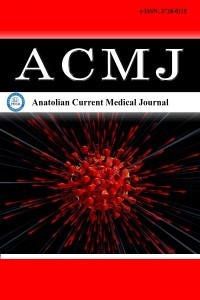1.
Jang S, Hwang S-O. Risk factors for atypical hyperplasia or endometrial cancer in premenopausal women aged ≤45 years with abnormal uterine bleeding. <em>Eur J Obstet Gynecol Reprod Biol</em>. 2024;302:288-293. doi:10.1016/j.ejogrb.2024.09.030
2.
Rezende GP, Gomes DAY, Benetti-Pinto CL. Abnormal uterine bleeding in reproductive age: a comparative analysis between the five Brazilian geographic regions. <em>Rev Assoc Med Bras (1992)</em>. 2023;69(suppl 1):e2023S111. doi:10.1590/1806-9282.2023S111
3.
Whitaker L, Critchley HO. Abnormal uterine bleeding. <em>Best Pract Res Clin Obstet Gynaecol</em>. 2016;34:54-65.
4.
Sabre A, Serventi L, Nuritdinova D, Schiattarella A, Sisti G. Abnormal uterine bleeding types according to the PALM-COEIN FIGO classification in a medically underserved American community. <em>J Turk Ger Gynecol Assoc</em>. 2021;22(2):91-96. doi:10. 4274/jtgga.galenos.2021.2020.0228
5.
Achanna KS, Nanda J. Evaluation and management of abnormal uterine bleeding. <em>Med J Malaysia</em>. 2022;77(3):374-383.
6.
Jones ER, O’Flynn H, Njoku K, Crosbie EJ. Detecting endometrial cancer. <em>Obstet Gynaecol</em>. 2021;23(2):103-112.
7.
Vitale SG, Watrowski R, Barra F. et al. Abnormal uterine bleeding in perimenopausal women: the role of hysteroscopy and its impact on quality of life and sexuality. <em>Diagnostics (Basel)</em>. 2022;12(5):1176. doi:10.3390/diagnostics12051176
8.
Brun JL, Plu-Bureau G, Huchon C. et al. Management of women with abnormal uterine bleeding: clinical practice guidelines of the French national college of gynaecologists and obstetricians (CNGOF). <em>Eur J Obstet Gynecol Reprod Biol</em>. 2023;288:90-107. doi:10.1016/j.ejogrb.2023.07.001
9.
van Maldegem LDPR, van der Zande JA, van Werkhoven LA, et al. Recurrent postmenopausal bleeding: pathological findings and predictive factors: a multicenter, prospective, observational study. <em>Acta Obstet Gynecol Scand</em>. 2024;103(7):1283-1291. doi:10. 1111/aogs.14851
10.
Van Den Bosch T, Verbakel JY, Valentin L, et al. Typical ultrasound features of various endometrial pathologies described using International Endometrial Tumor Analysis (IETA) terminology in women with abnormal uterine bleeding. <em>Ultrasound Obstet Gynecol</em>. 2021;57(1):164-172. doi:10.1002/uog.22109
11.
Su D, Li L, Zhong M, Xia Y. Capacity of endometrial thickness measurement to diagnose endometrial carcinoma in asymptomatic postmenopausal women: a systematic review and meta-analysis. <em>Ann Palliat Med</em>. 2021;10(10):10840-10848. doi:10.21037/apm-21-2516
12.
Zhang CY, Li H, Zhang S, et al. Abnormal uterine bleeding patterns determined through menstrual tracking among participants in the Apple Women’s Health Study. <em>Am J Obstet Gynecol</em>. 2023;228(2):213.e1-213.e22. doi:10.1016/j.ajog.2022.10.029
13.
Leal CRV, Vannuccini S, Jain V, et al. Abnormal uterine bleeding: the well-known and the hidden face. <em>J Endometr Uter Disord</em>. 2024;6:100071. doi:10.1016/j.jeud.2024.100071
14.
Karena ZV, Mehta AD, Vikani S. Palm-COEIN classification for abnormal uterine bleeding: a study of its practical applicability and distribution of causes. <em>J South Asian Fed Obstet Gynaecol</em>. 2023;14(6):681-684.
15.
Amiri M, Bidhendi-Yarandi R, Fallahzadeh A, et al. Polikistik over sendromlu kadınlarda endometrial, over ve meme kanseri riski: sistematik bir inceleme ve meta-analiz. <em>Int J Reprod Biomed (Yazd)</em>. 2022;20(11):893-914. doi:10.18502/ijrm.v20i11.12357
16.
Tsuji S, Nobuta Y, Hanada T, et al. Prevalence, definition, and etiology of cesarean scar defect and treatment of cesarean scar disorder: a narrative review. <em>Reprod Med Biol</em>. 2023;22(1):12532. doi:10.1002/rmb2.12532
17.
Jewson M, Purohit P, Lumsden MA. Progesterone and abnormal uterine bleeding/menstrual disorders. <em>Best Pract Res Clin Obstet Gynaecol</em>. 2020;69:62-73.
18.
Husain S, Al Hammad RS, Alduhaysh AK, et al. Pathological spectrum of endometrial biopsies in Saudi women with abnormal uterine bleeding: a retrospective study of 13-years. <em>Saudi Med J</em>. 2021;42(3):270-279. doi:10.15537/smj.2021.42.3.20200814
19.
Clarke MA, Long BJ, Sherman ME, et al. Risk assessment of endometrial cancer and endometrial intraepithelial neoplasia in women with abnormal bleeding and implications for clinical management algorithms. <em>Am J Obstet Gynecol</em>. 2020;223(4):549.e1-549.e11.
20.
Harvey SV, Wentzensen N, Bertrand K, et al. Associations of life course obesity with endometrial cancer in the Epidemiology of Endometrial Cancer Consortium (E2C2). <em>Int J Epidemiol</em>. 2023;52(4):1086-1099. doi:10.1093/ije/dyad046
21.
McVicker L, Cardwell CR, Edge L, et al. Survival outcomes in endometrial cancer patients according to diabetes: a systematic review and meta-analysis. <em>BMC Cancer</em>. 2022;22(1):427. doi:10. 1186/s12885-022-09510-7
22.
Main C, Chen X, Zhao M, et al. Understanding how pregnancy protects against ovarian and endometrial cancer development: fetal antigens may be involved. <em>Endocrinology</em>. 2022;163(11):bqac141.doi:10.1210/endocr/bqac141
23.
Keenahan L, Bercaw-Pratt JL, Adeyemi O, et al. Rates of intrauterine device expulsion among adolescents and young women. <em>J Pediatr Adolesc Gynecol</em>. 2021;34(3):362-365. doi:10. 1016/j.jpag.2020.11.003
24.
Raja RS, Ramakrishnan KK, Sekar A, Subbiah M, Natarajan P. Comparison of transabdominal sonography and transvaginal sonography in evaluation of endometrial thickness in the setting of abnormal uterine bleeding. <em>East J Med Sci</em>. 2023;8(1):15-19.
25.
American College of Obstetricians and Gynecologists. ACOG Committee opinion no. 426: the role of transvaginal ultrasonography in the evaluation of postmenopausal bleeding. <em>Obstet Gynecol</em>. 2009;113(2 Pt 1):462-464.
26.
Jain V, Chodankar RR, Maybin JA, Critchley HOD. Uterine bleeding: how understanding endometrial physiology underpins menstrual health. <em>Nat Rev Endocrinol</em>. 2022;18(5):290-308. doi:10.1038/s41574-021-00629-4
27.
Kılınç H, Cengiz H, Kaya C, Ekin M, Yaşar L. Endometrial patolojilerin değerlendirilmesinde transvajinal ultrasonografi ile ofis histeroskopinin karşılaştırılması. <em>Yeni Tıp Derg</em>. 2012; 29(1):23-26.
28.
Saccardi C, Spagnol G, Bonaldo G, et al. New light on endometrial thickness as a risk factor of cancer: what do clinicians need to know? <em>Cancer Manag Res</em>. 2022;14:1331-1340. doi:10.2147/CMAR.S294074
29.
Shen D, Mao W, Liu T, et al. Sedentary behavior and incident cancer: a meta-analysis of prospective studies. <em>PLoS One</em>. 2014; 9(8):e105709.
30.
Kumari P, Gaikwad HS, Nath B. Endometrial cut off thickness as predictor of endometrial pathology in perimenopausal women with abnormal uterine bleeding: a cross-sectional study. <em>Obstet Gynecol Int</em>. 2022;2022:5073944. doi:10.1155/2022/5073944

